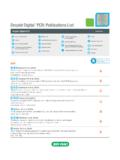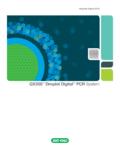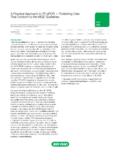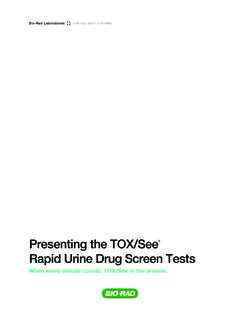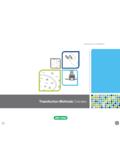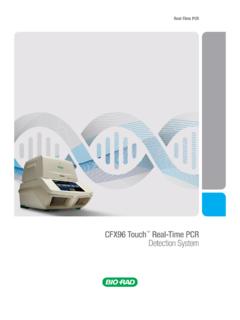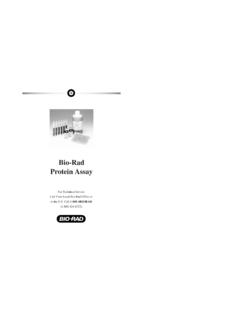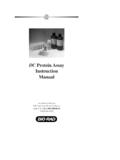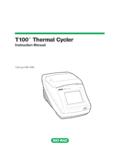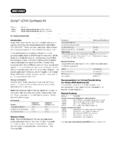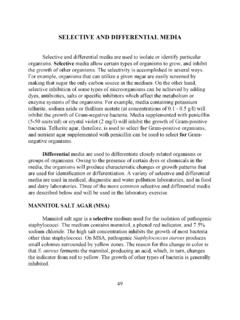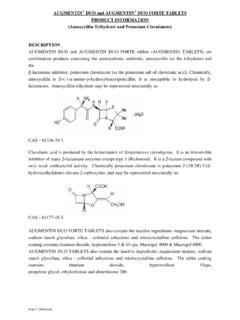Transcription of PASTOREXTM MENINGITIS 25 tests - Bio-Rad
1 PASTOREXTMMENINGITIS25 tests61607616116161661608616136161861610 6161461717 DETECTION OF SOLUBLE ANTIGENS AND IDENTIFICATION OF NEISSERIA MENINGITIDISA, C, Y/W135, ,HAEMOPHILUS INFLUENZAEb, STREPTOCOCCUSPNEUMONIAE, STREPTOCOCCUSB1- CLINICAL VALUEB acterial MENINGITIS is an infection of the meninges and the main causativeorganisms are: Neisseria meningitidis, streptococcus pneumoniae,Haemophilus influenzaetype b, and Streptococcusgroup is a serious situation, so it is important to diagnose the infectionrapidly in order to start appropriate treatment. The conventional technique ofidentification by culture, even though essential for the antibiogram andconfirmation of the diagnosis, is slow and can give false negative results if thespecimen has been transported and stored under unsatisfactory conditions, orif an antibiotic therapy has been initiated before the specimen was techniques for detecting soluble antigens released by thecausative organisms into biological fluids cerebrospinal fluid, urine, serum,during the infection, permit a more rapid diagnosis.
2 The soluble antigens thatcan be detected with this kit are the polysaccharides specific for certainserogroups or serotypes : streptococcus pneumoniae(83 types); Haemophilusinfluenzaetype b, Neisseria meningitidisgroup A, group , group C, group Y/W135, and Streptococcusgroup polysaccharide antigen specific for Meningococcus serogroup B is onlyvery slightly antigenic and it has always been very difficult to obtainreproducible rabbit antibodies specifically directed against this antibody technology applied to the preparation of specificbacterial polysaccharide antigens allows the production of monoclonal mouseantibodies capable of specifically and reproducibly recognising thepolysaccharide antigen of Meningococcus serogroup polysaccharide antigen specific for Meningococcus serogroup B.
3 Isidentical to a polysaccharide antigen found with This antigenichomology between Meningococcus B and permits the diagnosis in newborns, of which about 80 % are of the K1 should be noted that StreptococcusB are the principal bacteriaresponsible for MENINGITIS in the newborn and premature infants, and that themeningococcal infection is extremely rare in this age PRINCIPLEA ntigen contained in the specimen tested is identified using latex particlescoated with specific homologous antibodies. In the presence of thehomologous antigen, latex particles agglutinate. In the absence of antigen,they remain in a homogenous PRESENTATION1.
4 PASTOREXTMMENINGITIS 25 test kit, code 61607, consisting of : Reagent 1 (R1): N. 1 bottle with 0,40 ml of red latex sensitized with mouse monoclonalantibody specific for N. meningitidisgroup K1. Reagent 2 (R2): N. negative control1 bottle with 0,40 ml of red latex sensitized with mouse monoclonalantibody specific for tetanus toxoid. Reagent 3 (R3): H. influenzaeb 1 bottle with ml of white latex sensitized with rabbit antibodies specificfor H. influenzaetype b. Reagent 4 (R4): S. pneumoniae1 bottle with ml of green latex sensitized with rabbit antibodies specificfor S. pneumoniae.
5 Reagent 5 (R5): StreptococcusB 1 bottle with ml of yellow latex sensitized with rabbit antibodiesspecific for StreptococcusB. Reagent 6 (R6): N. meningitidisA 1 bottle with ml of blue latex sensitized with rabbit antibodies specificfor N. meningitidisgroup A. Reagent 7 (R7): N. meningitidisC 1 bottle with ml of red latex sensitized with rabbit antibodies specificfor N. meningitidisgroup C. Reagent 8 (R8): N. meningitidisY/W 135 1 bottle with ml of pink latex sensitized with rabbit antibodies specificfor N. meningitidisY/W 135 Reagent 9 (R9): Control polyvalent negative 1 bottle with ml of plum latex sensitized with IgG immunoglobulinsfrom non immunized rabbit.
6 Reagent 10 (R10): Control polyvalent positive Positive control: freeze dried antigenic extract to be reconstituted with 1 mlsterile water. Contains the polysaccharide antigens of N. meningitidisA, C,B, Y/W135, H. influenzaeb, StreptococcusB, and S. pneumoniae. Volumesufficient for 20 the reagents contain % R1, R2, R3, R4, R5, R6, R7, R8, R9 contain less than sodiumazide. Disposable agglutination cards. Disposable mixing PASTOREXTMMENINGITIS INDIVIDUAL LATEX tests (25 testseach): Single latex test (without control)-N. meningitidisA (R6)code 61608-N. meningitidisC (R7)code 61610- N. meningitidisB / E.
7 ColiK1 (R1)code 61611-StreptococcusB (R5)code 61613- streptococcus pneumoniae( R4)code 61614-Haemophilus influenzaeb (R3)code 61616 PASTOREXTMMENINGITIS control Control reagents kit for single latex test (for 2 x 25 tests )code 61618- 2 dropper bottles with ml of polyvalent negative control (R9)- 2 bottles of freeze dried polyvalent positive control (R10) to bereconstituted with 1 ml of sterile water- 2 dropper bottles with ml of negative control for / (R2)- disposable disposable mixing PASTOREXTMMENINGITIS Diluent1 bottle with 40 ml of diluent for sera treatmentcode 617174- STORAGEAll reagents are stable until the expiry dates indicated on the label, if stored at+2-8 C and in absence of microbial contamination (even once open).
8 The reconstituted polyvalent positive control R10 is stable for 1 month at+2-8 C(in absence of microbial contamination) or longer if aliquoted andfrozen at -20 C the latex reagent bottles LATEX REAGENTS MUST NOT BE NECESSARY MATERIAL NOT SUPPLIED Pipette for distributing one drop (40 to 50 l) of the specimen. Haemolysis or Eppendorf tubes Dry incubator or water-bath at 100 C. Centrifuge for haemolysis or Eppendorf tubes. Disinfectant bath Sterile distilled water, sterile saline or diluent (code 61717)6- PRECAUTIONSThe quality of results depends on complying strictly with Good LaboratoryPractice.
9 All the reagents and the sample should be used at a room temperaturebetween 18 and 25 C. Do not touch the reaction surface of the agglutination cards. Change the pipette or disposable tip for each sample tested. Shake the bottles of latex before use. Wipe the tip of the reagent dropper bottle in order to obtain well calibrateddrops. Hold the reagent bottle vertical to deposit drops. Change the mixing stick for each reaction. Discard all disposable material used in an autoclavable waste bin ordisinfectant bath. The polyvalent positive control should be reconstituted with distilled sterilewater avoiding any AND SAFETY INSTRUCTIONSA lways observe the current techniques and precautions concerning protectionagainst microbiological hazards.
10 All samples taken must be considered potentially PROCEDURE: CSF, serum, urineSamplesSamples should be treated as soon as possible after collection. If this is notpossible, they can be stored for a few hours between +2 and +8 C, or longerat -20 C (In this case, keep only the supernatant at 20 C after centrifugation).Avoid repeated freezing / thawing. Bacteriological examinations (culture)should be performed as a matter of priority in order to avoid contamination ofthe sample. The minimum volume of sample for testing with the latex kit is ) PREPARATION OF CLINICAL SAMPLESCAUTION:when using a water-bath, use watertight tubes to keep water fromentering the tubes.
